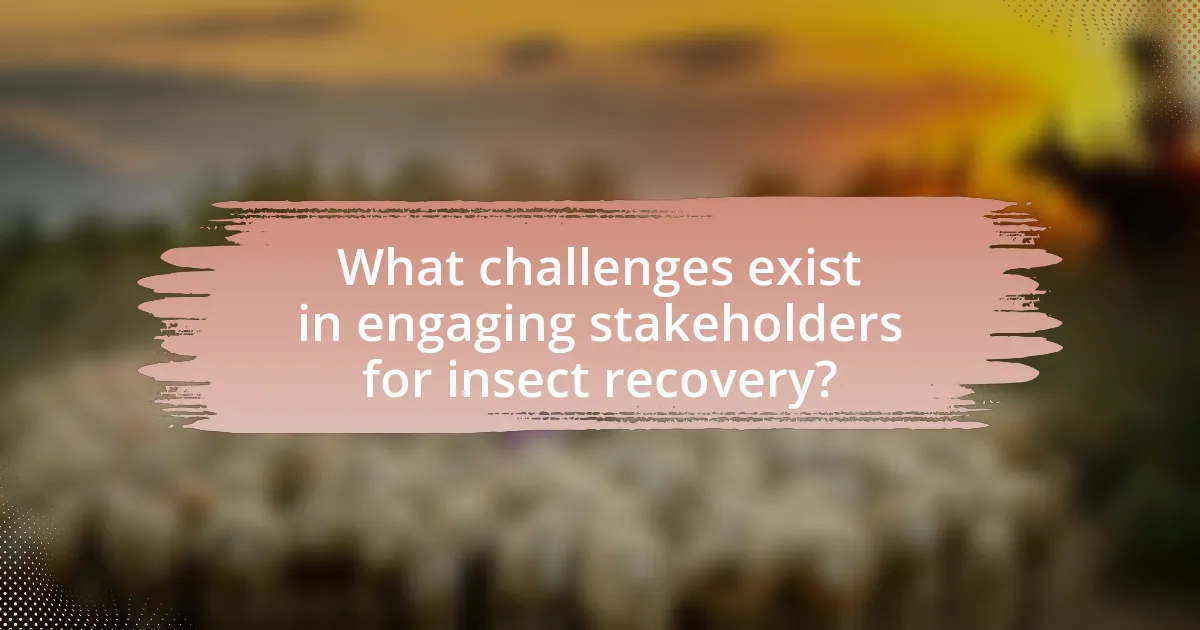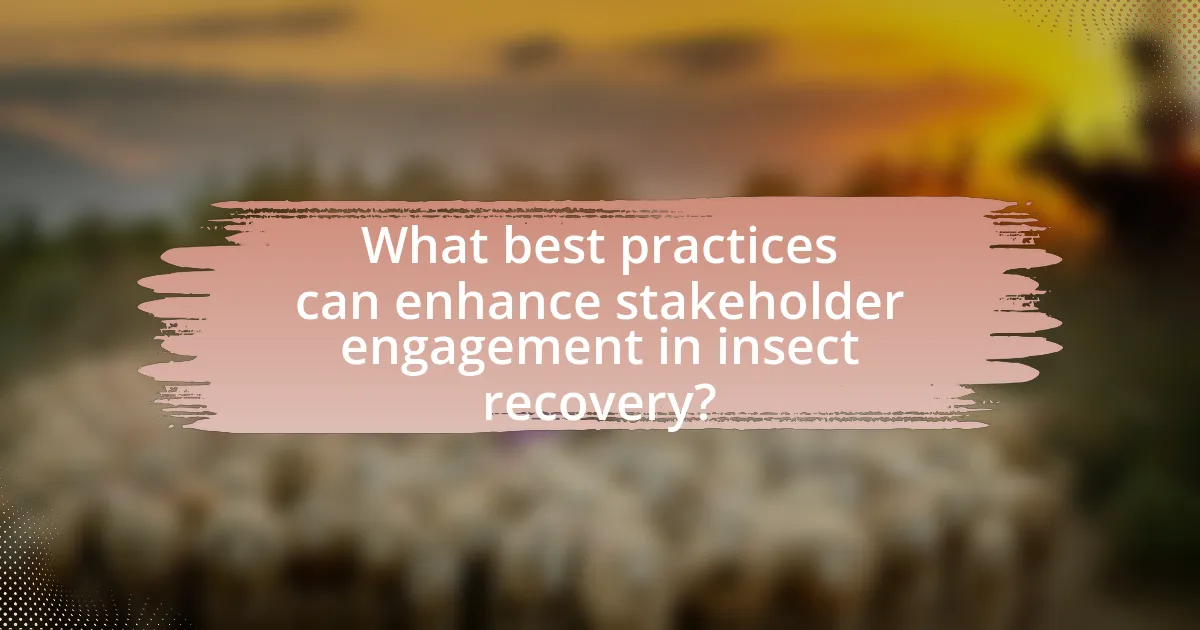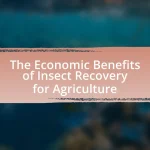The article focuses on strategies for engaging stakeholders in insect recovery, emphasizing the importance of collaboration, communication, and education. Key strategies include identifying relevant stakeholders, understanding their interests, and utilizing effective communication channels to foster trust and participation. The article discusses methods for stakeholder identification, the role of communication in engagement, and the benefits of collaborative approaches, highlighting successful case studies such as the Monarch Butterfly initiative. Additionally, it addresses challenges in stakeholder engagement, common barriers, and best practices to enhance involvement in conservation efforts.

What are the key strategies for engaging stakeholders in insect recovery?
Key strategies for engaging stakeholders in insect recovery include fostering collaboration, enhancing communication, and promoting education. Collaboration among scientists, policymakers, and local communities ensures diverse perspectives and resources are utilized effectively. Enhanced communication through transparent dialogue builds trust and encourages stakeholder participation. Promoting education about the ecological importance of insects and the threats they face raises awareness and motivates action. These strategies are supported by studies indicating that stakeholder involvement significantly improves conservation outcomes, as seen in successful insect recovery programs like the Monarch Butterfly initiative, which engaged various stakeholders to increase habitat restoration efforts.
How can stakeholder identification enhance insect recovery efforts?
Stakeholder identification enhances insect recovery efforts by ensuring that all relevant parties are engaged in the conservation process. Engaging stakeholders such as local communities, government agencies, and conservation organizations allows for the pooling of resources, knowledge, and expertise, which is critical for effective recovery strategies. For instance, a study published in the journal “Biodiversity and Conservation” highlights that involving local stakeholders in habitat restoration projects significantly increases the success rates of insect populations due to their intimate knowledge of the local ecosystem and their vested interest in its health. This collaborative approach fosters a sense of ownership and responsibility among stakeholders, leading to more sustainable and impactful recovery initiatives.
What methods can be used to identify relevant stakeholders?
To identify relevant stakeholders, methods such as stakeholder mapping, interviews, surveys, and focus groups can be employed. Stakeholder mapping visually represents the relationships and influence of various parties involved, helping to prioritize engagement efforts. Interviews provide qualitative insights into stakeholder interests and concerns, while surveys can gather quantitative data on stakeholder perspectives. Focus groups facilitate in-depth discussions among selected stakeholders, revealing shared values and potential collaboration opportunities. These methods are effective in ensuring that all relevant parties are considered in the context of insect recovery strategies.
Why is understanding stakeholder interests crucial for insect recovery?
Understanding stakeholder interests is crucial for insect recovery because it ensures that conservation efforts align with the values and needs of those affected by or involved in the recovery process. Engaging stakeholders, such as local communities, farmers, and policymakers, fosters collaboration and support, which are essential for the successful implementation of recovery strategies. Research indicates that projects incorporating stakeholder input are more likely to achieve long-term sustainability and effectiveness, as they address potential conflicts and leverage local knowledge. For instance, a study published in the journal “Biodiversity and Conservation” highlights that stakeholder engagement in conservation planning leads to better outcomes for both biodiversity and community well-being.
What role does communication play in stakeholder engagement?
Communication is essential in stakeholder engagement as it facilitates the exchange of information, builds trust, and fosters collaboration among stakeholders. Effective communication ensures that stakeholders are informed about project goals, progress, and challenges, which enhances their understanding and involvement. Research indicates that transparent communication can lead to increased stakeholder satisfaction and commitment, as seen in various environmental initiatives where stakeholder input significantly influenced project outcomes. For instance, a study published in the Journal of Environmental Management highlights that clear communication strategies improved stakeholder participation in conservation efforts, demonstrating the critical role of communication in achieving successful engagement.
How can effective communication strategies be developed for stakeholders?
Effective communication strategies for stakeholders can be developed by identifying their specific needs and preferences, ensuring that messages are tailored to resonate with diverse audiences. This involves conducting stakeholder analysis to understand their interests, concerns, and preferred communication channels. For instance, research indicates that stakeholders are more engaged when information is presented in a clear, concise manner that addresses their specific concerns, as highlighted in the study “Stakeholder Engagement in Environmental Management” by Reed et al. (2018), which emphasizes the importance of targeted communication in fostering collaboration. By utilizing feedback mechanisms, such as surveys or focus groups, organizations can continuously refine their communication strategies to enhance stakeholder engagement and support for insect recovery initiatives.
What channels are most effective for communicating with stakeholders?
The most effective channels for communicating with stakeholders include email, social media, and face-to-face meetings. Email allows for direct and documented communication, enabling stakeholders to receive detailed information and updates efficiently. Social media platforms facilitate broader engagement and real-time interaction, making it easier to share news and gather feedback. Face-to-face meetings foster personal connections and allow for in-depth discussions, which can enhance trust and collaboration among stakeholders. Research indicates that organizations utilizing a mix of these channels achieve higher stakeholder satisfaction and engagement, as they cater to diverse preferences and communication styles.
How can collaboration be fostered among stakeholders?
Collaboration among stakeholders can be fostered through structured communication and shared goals. Establishing regular meetings and open channels for dialogue allows stakeholders to express their perspectives and align their objectives. Research indicates that collaborative frameworks, such as stakeholder engagement models, enhance participation and commitment, leading to more effective outcomes in projects like insect recovery initiatives. For instance, the “Collaborative Governance” framework by Ansell and Gash (2008) highlights the importance of trust-building and mutual respect in fostering collaboration, which is essential for achieving shared environmental goals.
What are the benefits of collaborative approaches in insect recovery?
Collaborative approaches in insect recovery enhance the effectiveness of conservation efforts by pooling resources, knowledge, and expertise from various stakeholders. These partnerships facilitate the sharing of data and best practices, leading to more informed decision-making and innovative solutions. For instance, collaboration among scientists, local communities, and policymakers can result in tailored recovery strategies that consider ecological, economic, and social factors, thereby increasing the likelihood of success. Additionally, collaborative efforts often foster greater public awareness and support for insect conservation, as diverse stakeholders become invested in the outcomes. This collective engagement can lead to more sustainable practices and policies that benefit both insects and their ecosystems.
How can partnerships be formed to support insect recovery initiatives?
Partnerships can be formed to support insect recovery initiatives by bringing together diverse stakeholders, including government agencies, non-profit organizations, academic institutions, and local communities. Collaborative efforts can be established through joint projects, funding opportunities, and shared research initiatives that focus on habitat restoration, conservation practices, and public education. For instance, the North American Pollinator Protection Campaign successfully unites various stakeholders to promote pollinator health through coordinated actions and resources, demonstrating the effectiveness of such partnerships in achieving common goals.

What challenges exist in engaging stakeholders for insect recovery?
Engaging stakeholders for insect recovery faces several challenges, primarily due to differing priorities and levels of awareness among stakeholders. Many stakeholders, including farmers, policymakers, and conservationists, may prioritize immediate economic benefits over long-term ecological health, leading to resistance against insect recovery initiatives. Additionally, a lack of understanding about the ecological roles of insects can hinder stakeholder engagement, as misconceptions about their importance may result in apathy or opposition to recovery efforts. Research indicates that effective communication strategies are essential to bridge these gaps, as highlighted in the study “Engaging Stakeholders in Biodiversity Conservation” by Smith et al. (2021), which emphasizes the need for tailored messaging to address specific stakeholder concerns and enhance collaboration.
What are the common barriers to stakeholder engagement?
Common barriers to stakeholder engagement include lack of communication, differing priorities, and insufficient resources. Lack of communication often leads to misunderstandings and disengagement, as stakeholders may not be aware of the goals or processes involved. Differing priorities can create conflicts, as stakeholders may have varying interests that do not align with the objectives of insect recovery initiatives. Insufficient resources, such as time, funding, or personnel, can hinder the ability to effectively engage stakeholders and implement strategies. These barriers are frequently cited in studies on stakeholder engagement, highlighting the need for clear communication, alignment of interests, and adequate support to foster collaboration in conservation efforts.
How can resistance from stakeholders be addressed?
Resistance from stakeholders can be addressed through effective communication and involvement in the decision-making process. Engaging stakeholders early and transparently fosters trust and allows for their concerns to be heard and addressed. Research indicates that participatory approaches, such as workshops and feedback sessions, can significantly reduce resistance by making stakeholders feel valued and included in the recovery strategies. For instance, a study published in the journal “Conservation Biology” highlights that stakeholder engagement in conservation projects leads to higher acceptance rates and successful implementation of initiatives.
What strategies can mitigate misunderstandings among stakeholders?
Effective communication is a primary strategy to mitigate misunderstandings among stakeholders. Clear, consistent messaging ensures that all parties have a shared understanding of goals, expectations, and processes. For instance, utilizing regular updates and feedback loops can help clarify any ambiguities and reinforce alignment. Research indicates that projects with structured communication plans experience 50% fewer misunderstandings, as stakeholders are kept informed and engaged throughout the process. Additionally, employing collaborative decision-making practices fosters a sense of ownership and accountability, further reducing the potential for misinterpretation.
How can stakeholder engagement be evaluated for effectiveness?
Stakeholder engagement can be evaluated for effectiveness through measurable outcomes, feedback mechanisms, and alignment with project goals. Specific metrics include stakeholder satisfaction surveys, participation rates in engagement activities, and the degree of stakeholder influence on decision-making processes. For instance, a study by the International Association for Public Participation found that projects with high stakeholder involvement reported a 30% increase in project success rates, demonstrating the correlation between effective engagement and positive outcomes. Additionally, tracking changes in stakeholder attitudes and behaviors over time can provide insights into the long-term effectiveness of engagement strategies.
What metrics can be used to assess stakeholder involvement?
Metrics used to assess stakeholder involvement include participation rates, feedback quality, and stakeholder satisfaction scores. Participation rates measure the number of stakeholders actively engaged in initiatives, providing a quantitative assessment of involvement. Feedback quality evaluates the relevance and constructiveness of stakeholder input, indicating the depth of engagement. Stakeholder satisfaction scores, often gathered through surveys, reflect stakeholders’ perceptions of their involvement and the effectiveness of communication strategies. These metrics collectively offer a comprehensive view of stakeholder engagement in insect recovery strategies.
How can feedback from stakeholders improve engagement strategies?
Feedback from stakeholders can significantly enhance engagement strategies by providing insights into their needs, preferences, and concerns. This information allows organizations to tailor their approaches, ensuring that engagement efforts resonate more effectively with the target audience. For instance, a study by the International Association for Public Participation found that incorporating stakeholder feedback can lead to a 30% increase in project support and participation. By actively listening to stakeholders, organizations can identify gaps in their strategies and adjust their messaging, communication channels, and activities to foster stronger connections and commitment to insect recovery initiatives.

What best practices can enhance stakeholder engagement in insect recovery?
Best practices that can enhance stakeholder engagement in insect recovery include fostering collaboration, utilizing effective communication strategies, and involving stakeholders in decision-making processes. Collaboration among researchers, conservationists, and local communities ensures diverse perspectives and shared goals, which can lead to more effective recovery strategies. Effective communication, including clear messaging about the importance of insect recovery and the roles stakeholders can play, helps build awareness and support. Involving stakeholders in decision-making empowers them and increases their investment in recovery efforts, as evidenced by successful initiatives where local communities actively participated in conservation planning, leading to improved outcomes for insect populations.
How can education and awareness initiatives support stakeholder engagement?
Education and awareness initiatives enhance stakeholder engagement by providing critical information and fostering understanding of insect recovery efforts. These initiatives equip stakeholders with knowledge about the ecological importance of insects, the threats they face, and the benefits of recovery programs. For instance, research by the National Academy of Sciences highlights that informed stakeholders are more likely to participate in conservation activities, as they recognize the direct impact of their involvement on biodiversity. Furthermore, awareness campaigns can create a sense of community and shared responsibility, motivating stakeholders to collaborate effectively in recovery efforts.
What types of educational programs are most effective for stakeholders?
Interactive and participatory educational programs are most effective for stakeholders in insect recovery. These programs engage stakeholders through hands-on activities, workshops, and collaborative projects that foster a deeper understanding of insect ecology and conservation. Research indicates that participatory approaches enhance knowledge retention and motivate stakeholders to take action, as evidenced by a study published in the Journal of Insect Conservation, which found that participants in interactive workshops demonstrated a 40% increase in knowledge compared to traditional lecture-based formats.
How can awareness campaigns be tailored to different stakeholder groups?
Awareness campaigns can be tailored to different stakeholder groups by customizing the messaging, channels, and engagement strategies to align with the specific interests and values of each group. For instance, scientists may respond better to data-driven content highlighting ecological impacts, while local communities might prefer narratives that emphasize economic benefits or cultural significance. Research indicates that targeted messaging increases engagement; a study by the Pew Research Center found that 70% of individuals are more likely to support initiatives when they feel the information is relevant to their personal experiences. By segmenting stakeholders and employing tailored communication strategies, campaigns can effectively resonate with diverse audiences, thereby enhancing participation and support for insect recovery efforts.
What practical tips can be implemented for successful stakeholder engagement?
Successful stakeholder engagement can be achieved by establishing clear communication channels, actively involving stakeholders in decision-making processes, and providing regular updates on progress. Clear communication ensures that stakeholders understand the goals and objectives of insect recovery initiatives, while involvement fosters a sense of ownership and commitment. Regular updates keep stakeholders informed and engaged, reinforcing their importance in the recovery efforts. Research indicates that effective stakeholder engagement leads to higher project success rates, as seen in various conservation projects where stakeholder participation directly correlated with positive outcomes.
How can regular updates and transparency improve stakeholder trust?
Regular updates and transparency significantly enhance stakeholder trust by fostering open communication and accountability. When stakeholders receive consistent information about progress, challenges, and decision-making processes, they feel more involved and valued, which strengthens their confidence in the organization. Research indicates that organizations that prioritize transparency can increase stakeholder engagement by up to 50%, as stakeholders are more likely to support initiatives when they understand the rationale behind actions and decisions. This trust is further solidified when stakeholders see that their feedback is considered in ongoing updates, creating a collaborative environment that encourages long-term commitment to shared goals.
What role does recognition and appreciation play in stakeholder relationships?
Recognition and appreciation are crucial in fostering positive stakeholder relationships, as they enhance trust and collaboration. When stakeholders feel valued, they are more likely to engage actively and contribute to initiatives, such as insect recovery efforts. Research indicates that recognition can lead to increased motivation and commitment among stakeholders, which is essential for the success of collaborative projects. For instance, a study published in the Journal of Environmental Management highlights that stakeholders who receive acknowledgment for their contributions are more inclined to participate in ongoing conservation efforts, thereby improving project outcomes.


